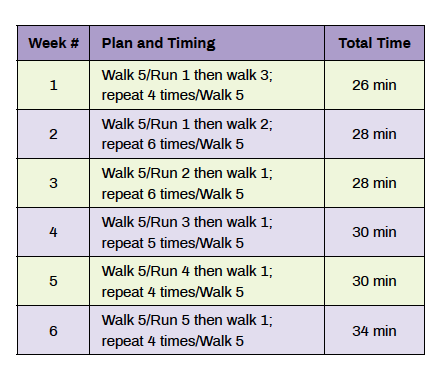
Running has great appeal in the age of coronavirus. Here on the Outer Cape, you can probably set out on a run right outside your front door. It doesn’t require much in the way of gear, aside from a good pair of shoes, and it burns a lot of calories. But mainly, what makes it so appealing right now is that running feels like the opposite of being confined — it’s liberating.
It’s easy to get hurt running, though, especially if you overdo it. The impact on your legs is around three to four times your body weight. That’s twice as much as the force your joints are absorbing when you walk.
If this strange season has you wanting to start running, or resume after a long hiatus, you’ve got to think about how to do it safely. You know the saying “You have to walk before you can run”? My strategy is to take that literally. If you walk regularly and can cover 12 to 15 miles per week, then you’re ready to begin a run/walk routine. If you’re not there yet, start walking 20 to 30 minutes a day, then add five minutes to each walk every week, until you reach 45 to 60 minutes a day.
Once your walking routine is strong, you can begin to add running in short intervals to create a run/walk program. Introducing the higher impact gradually gives your bones, muscles and tendons time to adapt. Do the walk/run workouts three times a week on non-consecutive days to allow your body time to recover in between. Continue walking or cross training on the other days.
You don’t have to graduate from run/walk workouts to running. I used a run/walk method to prepare for a marathon in Reykjavik in 2014. Throughout the race, I took a walking break after every five kilometers.
Before you head out, do a dynamic warmup such as high knees, butt kicks, or straight leg kicks. Always walk five minutes at the beginning to get yourself going and another five at the end to cool down. A beginner’s plan looks something like this:
 If you find the workouts too easy, you can progress more quickly. If they’re too difficult, go back a week or repeat a week until it feels manageable. Listen to your body; you’re looking for moderate exertion, say seven or eight on a 10-point scale, not an all-out effort.
If you find the workouts too easy, you can progress more quickly. If they’re too difficult, go back a week or repeat a week until it feels manageable. Listen to your body; you’re looking for moderate exertion, say seven or eight on a 10-point scale, not an all-out effort.
Your total time or mileage should increase gradually, about 10 percent per week. There’s no drama in going from a 30-minute run/walk workout to a 33-minute one. But it works. And most injuries come from running too much too soon.
To stay motivated, it’s helpful to have a clear goal in mind. Right now, I’m training for a solo 5K on May 2. I don’t think the Brewster in Bloom race will happen, but I’ve kept that date on my calendar anyway. Run your solo 5K on any scenic route you like. Choose one that’s away from other people, measure out a course (I use the phone app Map My Walk), mark your calendar, and train for it. When the day comes, do it, rain or shine. Make a big deal of it and reward yourself. Congratulations — running a 5K is an accomplishment, even when the competition is just you.



